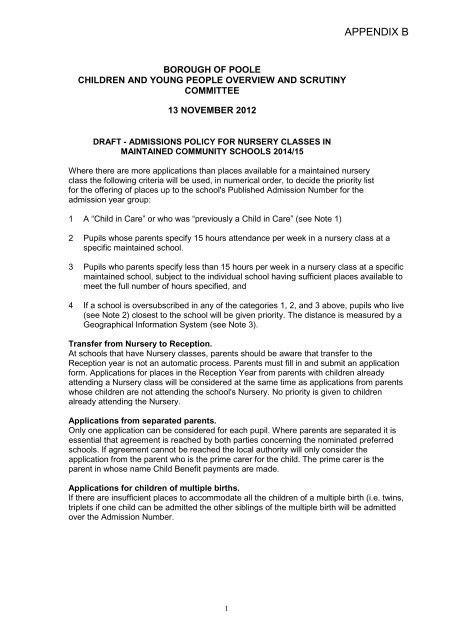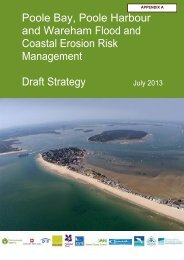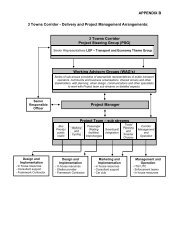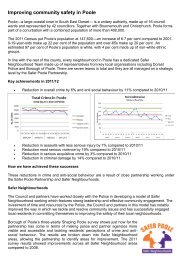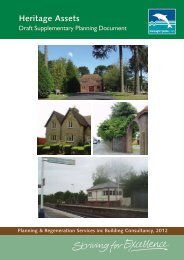APPENDIX B
(Attachment: 11)Appendix B (57K/bytes) - Borough of Poole
(Attachment: 11)Appendix B (57K/bytes) - Borough of Poole
- No tags were found...
Create successful ePaper yourself
Turn your PDF publications into a flip-book with our unique Google optimized e-Paper software.
<strong>APPENDIX</strong> B<br />
BOROUGH OF POOLE<br />
CHILDREN AND YOUNG PEOPLE OVERVIEW AND SCRUTINY<br />
COMMITTEE<br />
13 NOVEMBER 2012<br />
DRAFT - ADMISSIONS POLICY FOR NURSERY CLASSES IN<br />
MAINTAINED COMMUNITY SCHOOLS 2014/15<br />
Where there are more applications than places available for a maintained nursery<br />
class the following criteria will be used, in numerical order, to decide the priority list<br />
for the offering of places up to the school's Published Admission Number for the<br />
admission year group:<br />
1 A “Child in Care” or who was “previously a Child in Care” (see Note 1)<br />
2 Pupils whose parents specify 15 hours attendance per week in a nursery class at a<br />
specific maintained school.<br />
3 Pupils who parents specify less than 15 hours per week in a nursery class at a specific<br />
maintained school, subject to the individual school having sufficient places available to<br />
meet the full number of hours specified, and<br />
4 If a school is oversubscribed in any of the categories 1, 2, and 3 above, pupils who live<br />
(see Note 2) closest to the school will be given priority. The distance is measured by a<br />
Geographical Information System (see Note 3).<br />
Transfer from Nursery to Reception.<br />
At schools that have Nursery classes, parents should be aware that transfer to the<br />
Reception year is not an automatic process. Parents must fill in and submit an application<br />
form. Applications for places in the Reception Year from parents with children already<br />
attending a Nursery class will be considered at the same time as applications from parents<br />
whose children are not attending the school's Nursery. No priority is given to children<br />
already attending the Nursery.<br />
Applications from separated parents.<br />
Only one application can be considered for each pupil. Where parents are separated it is<br />
essential that agreement is reached by both parties concerning the nominated preferred<br />
schools. If agreement cannot be reached the local authority will only consider the<br />
application from the parent who is the prime carer for the child. The prime carer is the<br />
parent in whose name Child Benefit payments are made.<br />
Applications for children of multiple births.<br />
If there are insufficient places to accommodate all the children of a multiple birth (i.e. twins,<br />
triplets if one child can be admitted the other siblings of the multiple birth will be admitted<br />
over the Admission Number.<br />
1
Notes<br />
1. A “Child in Care” means any child who is in the care of a local authority in<br />
accordance with Section 22 (1) of the Children Act 1989. A child who was<br />
“Previously a Child in Care” means a child who, after being Looked After, became<br />
subject to an Adoption Order under Section 46 of the Adoption and Children Act<br />
2002, a Residence Order under Section 8 of the Children Act 1989 or Special<br />
Guardianship Order under Section 14A of the Children Act 1989.<br />
2. The local authority will consider that a child lives at the address at which he/she<br />
lives during the school week. Where a child lives at more than one address during<br />
the school week the local authority will consider the home address as being where<br />
the prime carer resides. The “prime carer” is the person in whose name Child<br />
Benefit payments for the individual child are made. The final decision on the home<br />
address of a child will be made by the local authority. If any information supplied<br />
by an applicant is judged by the local authority to be fraudulent or intentionally<br />
misleading the local authority may refuse to offer a place or, if already offered,<br />
may withdraw the offer.<br />
3. (a) The distance from home to school is measured by using the shortest, safest,<br />
practicable walking route using the centre line of public roads and footpaths<br />
(excluding paths identified for the sole use of bicycles i.e. cycleways) from the<br />
nearest point on the public highway to the centre point of the pupil’s home<br />
address (see Note 2 above) to a point opposite the nearest approved access point<br />
on school property that is for the use of pupils. The GIS maps used are provided<br />
by Ordnance Survey and represent the position as at the beginning of the annual<br />
admission cycle i.e. September in the year prior to admission. Any footpaths or<br />
roads added after this time will not be taken into consideration until the next<br />
academic year of application.<br />
(b) For applicants living on islands within Poole harbour the distance<br />
measurement will be a straight line from the centre point of the home property<br />
(see Note 2) to either:<br />
1. the nearest public landing steps at Poole Quay, or<br />
2. a point on the mainland that the applicant proves to the satisfaction of the<br />
local authority that he/she can access<br />
and from that point the distance will be measured using the shortest, safest,<br />
practicable walking route to the nearest point on the public highway and from<br />
there using the shortest, safest, practicable walking route using the centre line of<br />
public roads and footpaths (excluding paths identified for the sole use of bicycles<br />
i.e. cycleways) to a point opposite the nearest approved access point on school<br />
property that is for the use of pupils.<br />
(c) If an applicant advises the local authority that the child would or could use the<br />
Sandbanks Chain Ferry in the journey to school then the distance will be<br />
measured on that basis from the home address (see Note 2) in line with Note 3(a)<br />
above, including the distance travelled by the ferry.<br />
2
4. If there are insufficient places to accommodate all applicants and the distance<br />
criterion is used, the local authority will use random allocation for applicants living<br />
at the same address or in the same block of flats who are eligible for the<br />
remaining places. Applicants will have their names drawn as lots to see who<br />
should be offered the place(s). The person drawing the names will be an officer<br />
within Children & Young People’s Integrated Services who has no involvement in<br />
the school admissions process.<br />
3


